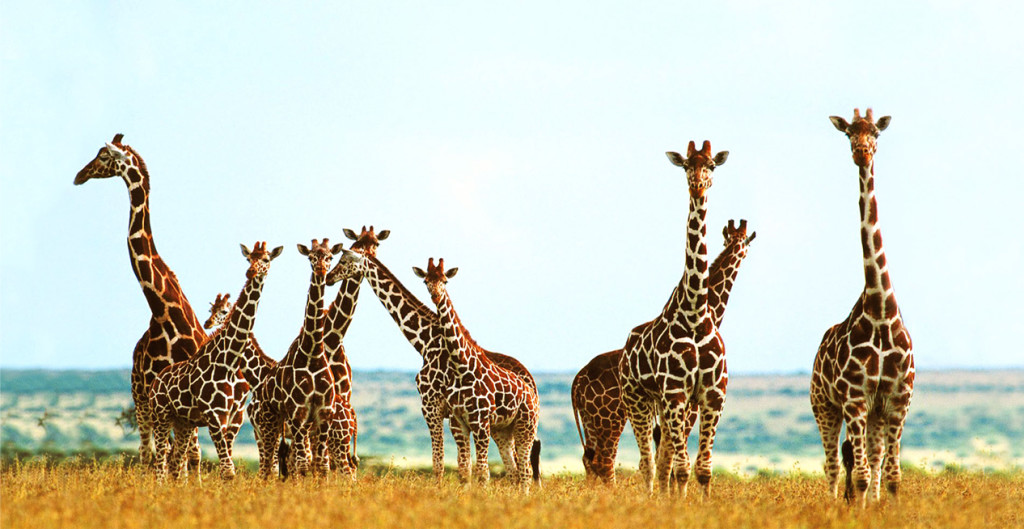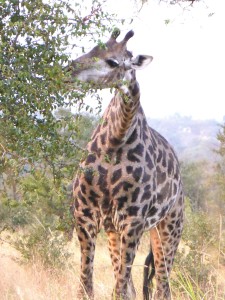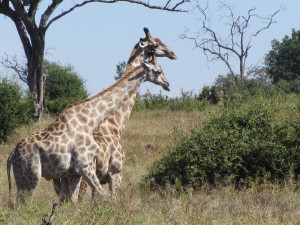by Carol Glassman

The giraffe is a creature that has always attracted attention, mainly because of its appearance. It has the longest neck of any mammal: approximately six feet, topped by a special axis joint that allows it to extend even further. It sports a ridiculously long, 18 to 20-inch pink and blackish-purple tongue, and bats those impossibly beautiful eyelashes which protect its eyes from blowing sand. To these physical attributes Mother Nature added a set of horn-like bony ossicones to its head, and long, strong, knob-kneed legs that make them the tallest land animals in the world, at a height of almost 20 feet. They wear attractive patchy coats similar to that of a leopard, the pattern of which no two giraffes share. Not only do the patches on a giraffe’s skin act as camouflage, but they are also part of a very sophisticated system of blood vessels which control body heat.
If you didn’t already know and were told humans have seven bones in their necks, could you guess how many are in the neck of a giraffe? Like all mammals, giraffes also have seven bones, but each cervical vertebrae is about 10 inches long.
According to a paper published by the Royal Society Open Science (25 November 2015) that compared fossil vertebrae analysis, from about 7 million years ago, there was an ‘intermediate’ or ‘transitional’ species from part of Eurasia, Samos in Greece, South Italy, Turkey, Moldavia, Iran and China with neck bones from the only two living members of the Giraffidae family: the giraffe (Giraffa camelopardalis) and okapi (Okapia johnstoni), a short-necked mammal that lives in central Africa. The ancient member of this species did not have such a long neck and showed other skeletal differences as well. Its closest relative is the okapi. There is only one species of giraffe and nine currently recognized sub-species with different coat patterns, living in parts of Africa.
According to giraffe protection agencies like IUCN (International Union for Conservation of Nature and Natural Resources) the total number of giraffes in Africa was estimated in 1999 to exceed 140,000, (of which 40% were in or around protected areas and private lands) and such numbers were thought capable of being maintained if they were adequately protected.
“Current estimates have the population at less than 80,000 individuals across all (sub)species. This is a considerable drop in the last decade and shows that the plight of giraffes is in real danger. Efforts are underway to build up an accurate census of the entire population – working closely with IUCN SSC ASG International Giraffe Working Groups. With the exception of Angolan, Cape and West African giraffes, all other subspecies are either decreasing and/or unstable. Poaching, human population growth, habitat loss, habitat fragmentation and habitat degradation continue to impact on the giraffe’s distribution across the continent.”
Today, the IUCN states important safety havens for giraffes in Africa include but are not limited to: Waza N. P. and the adjacent hunting zones (Cameroon), Zakouma N. P. (Chad), southwest Niger, Murchison Falls N. P. (Uganda), the Mara/Serengeti ecosystem (Kenya/Tanzania), Selous/Ruaha (Tanzania), Laikipia (Kenya), South Luangwa N. P. (Zamibia) and in southern Africa: Etosha N. P. (Namibia), Okavango Delta (Botswana), Hwange N. P. (Zimbabwe) and Kruger N. P. (South Africa).
Most people see giraffes in a zoo where they really stand out, but in their natural African habitat their coats are great camouflage. While other herbivores feast on grass and small plants, giraffes have access to the tender high leaves of trees, particularly the thorny acacia tree. Their very large tongues and thick, sticky saliva enable them to work around the thorns while the dark color on the end of the tongue prevents it from getting sunburned. This video illustrates how a giraffe uses its tongue to reach high leaves. www.youtube.com/watch
The six-foot neck of an average giraffe weighs about 600 pounds and is trimmed with a short, tufted mane. Although its back legs look shorter they are actually almost the same size as the front. While their lungs can hold 12 gallons of air, the two-foot long heart weighs almost 25 pounds, and is needed to generate almost double the normal blood pressure for a large mammal, to maintain blood flow to the brain against gravity. It circulates almost 16 gallons of blood throughout its body every minute. Giraffes have a complex blood pressure regulation system in their upper necks to prevent excess blood flow to the brain when they lower their heads to drink. Meanwhile, the blood vessels in the lower legs are under great pressure (because of the weight of fluid pressing down on them).Giraffes have a unique system, studied by NASA astronauts, which is a very tight sheath of thick skin over their lower limbs maintaining high extravascular pressure in exactly the same way as a pilot’s g-suit.
Giraffes are ruminants, chewing cud like cattle. Acacia leaves contain a lot of water so although giraffes can last for long periods without drinking, perhaps only once every few days, when water is available they can drink 10 gallons per day. Since a giraffe’s neck is too short to reach the ground, it has to spread its front legs or kneel to reach the ground for a drink of water.
Giraffes seem to need only 15- 30 minutes of sleep every 24 hours, often taking quick naps either standing up or lying down, their heads resting on their rumps. Their gait, in which both the front and back legs on one side move forward together, then the other two legs on the other side move forward, is called ‘pacing’. Giraffes can run a very quick 35 miles an hour for short distances.
Although giraffes seem to be pretty quiet, they do snuffle, hiss, and snort and are thought to emit sounds below the level of human hearing to communicate. Their height allows them to keep a good lookout for predators, mainly lions and crocodiles, and when attacked, a mighty karate-like kick from their hind legs and large, 12-inch diameter feet can be lethal to an enemy. They usually post a sentinel when eating or sleeping, and when one begins to run, the entire herd springs into action, gliding gracefully through the trees and across the savanna.
It is not known exactly how long giraffes live in the wild as there is no recorded data, but it is believed that males (bulls) and females (cows) have a life span of 25 years and perhaps longer in captivity.
Female giraffes give birth standing up. The baby falls six feet to the ground, breaking the three-foot umbilical cord and standing in about one hour. Only about 50% of calves survive their first year.
Clearly, this fascinating creature with all of its unusual physical attributes is not just another pretty face (with lovely eyelashes) but a magnificent and stately example of natural design.



Photos taken in Chobe National Park, Botswana
and Kruger National Park, northeastern South Africa
Photography by Carol Glassman
